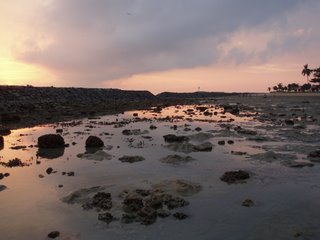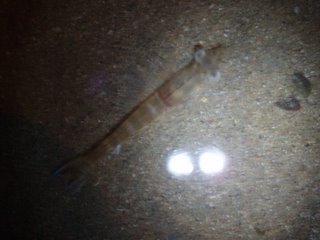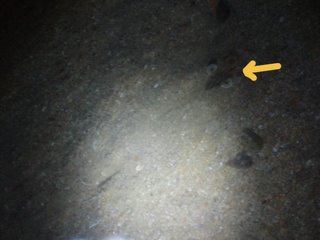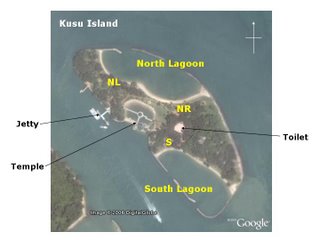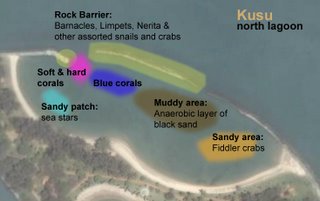dive tioman 12-14 may 2006
despite once swearing that i would never make another road trip to malaysia during a public holiday long weekend (read previous post of old travel report on tioman for reason) , i headed off to tioman again during vesak day long weekend like a moth attracted to fire.
took several precautions this time though. like 1) arranging for our minivan to pick us up at the unearthly hour of 5.45am so that we can reach the singapore/malaysia immigration points half hour earlier than all the public coaches, and 2) going by the second link at tuas, which is more costly but less likely to have traffic jams. the additional cost of S$10 was well worth it cos we cleared through the customs in about half hour. the driver's sources informed him that there was a bad traffic jam at the woodlands checkpoint.
we were early and had time to stop over at jb for breakfast.
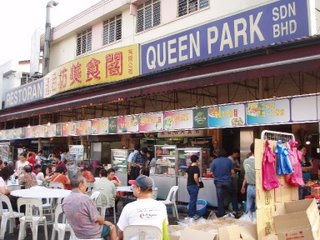
restoran queen park had an exciting array of chinese food. there was chye tau kueh, wanton mee, fishball noodles, dim sum etc etc. it was just half hour from second link.

satisfied after a good breakfast.
we were on the roads again at 8am and arrived at mersing around 15 past 10. ferry was at 11.30am and we had more than an hour to kill.

chilling out at cafe at mersing. teh limau was very refreshing on a hot day.
ferry was late as usual. we set off around 12pm. should have bought ramly burger to eat along the way. the boat operator loaded more passengers than the boat capacity allowed for. so some passengers did not have proper seats.
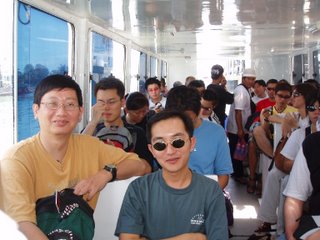
arrived tioman around 1.30pm. a warm welcome by gazillion bats hanging from the rhu tree.. eeewwwwwww

moved into room 302 on first floor. not as nice as the room 307 on second floor which i stayed in during previous trip. first floor no privacy. we kept curtains closed all the time so it was dark and looked pretty seedy esp with the red light from the bedside lamp and the pimply red blankets.

for the first time, organized toiletries! courtesy of mdm wong....
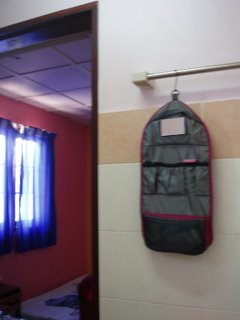
the divers
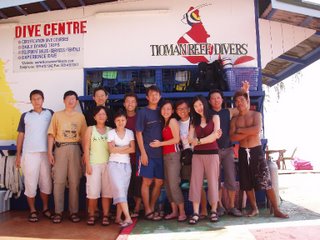
back row (from left): raymond (virgin contact lens wearer), freddy (secret agent), bernard (diver who's unrecognisable uw), mark (my reluctant part-time buddy), matthew & jo (loving couple), sharon (xiaojie from the famous Room 302), joyce & edy (pseudo couple), abect (dive guide)
front row (from left): ros (virgin leisure diver), me
took several precautions this time though. like 1) arranging for our minivan to pick us up at the unearthly hour of 5.45am so that we can reach the singapore/malaysia immigration points half hour earlier than all the public coaches, and 2) going by the second link at tuas, which is more costly but less likely to have traffic jams. the additional cost of S$10 was well worth it cos we cleared through the customs in about half hour. the driver's sources informed him that there was a bad traffic jam at the woodlands checkpoint.
we were early and had time to stop over at jb for breakfast.

restoran queen park had an exciting array of chinese food. there was chye tau kueh, wanton mee, fishball noodles, dim sum etc etc. it was just half hour from second link.

satisfied after a good breakfast.
we were on the roads again at 8am and arrived at mersing around 15 past 10. ferry was at 11.30am and we had more than an hour to kill.

chilling out at cafe at mersing. teh limau was very refreshing on a hot day.
ferry was late as usual. we set off around 12pm. should have bought ramly burger to eat along the way. the boat operator loaded more passengers than the boat capacity allowed for. so some passengers did not have proper seats.

arrived tioman around 1.30pm. a warm welcome by gazillion bats hanging from the rhu tree.. eeewwwwwww

moved into room 302 on first floor. not as nice as the room 307 on second floor which i stayed in during previous trip. first floor no privacy. we kept curtains closed all the time so it was dark and looked pretty seedy esp with the red light from the bedside lamp and the pimply red blankets.

for the first time, organized toiletries! courtesy of mdm wong....

the divers

back row (from left): raymond (virgin contact lens wearer), freddy (secret agent), bernard (diver who's unrecognisable uw), mark (my reluctant part-time buddy), matthew & jo (loving couple), sharon (xiaojie from the famous Room 302), joyce & edy (pseudo couple), abect (dive guide)
front row (from left): ros (virgin leisure diver), me
